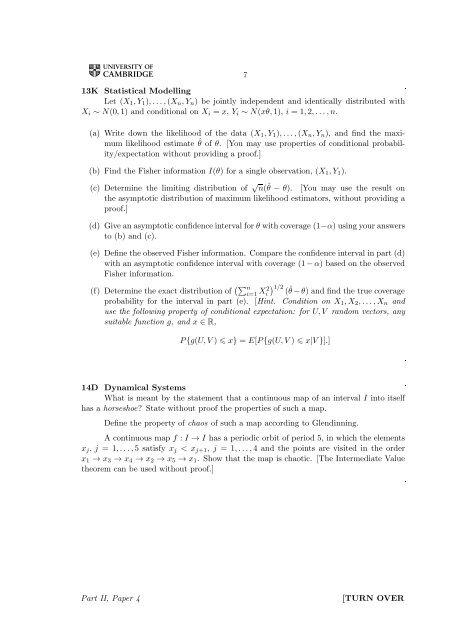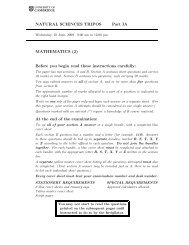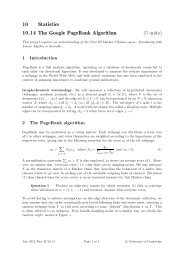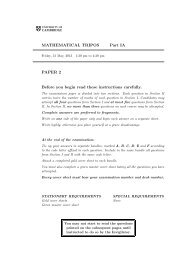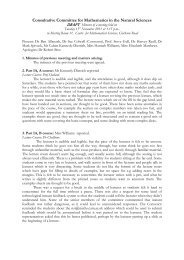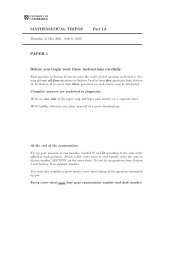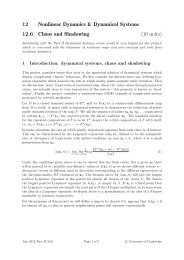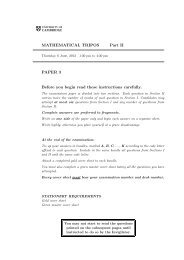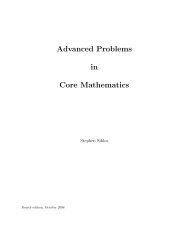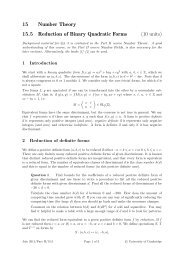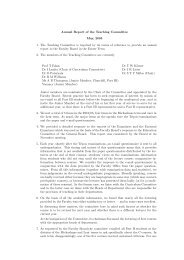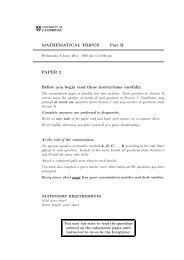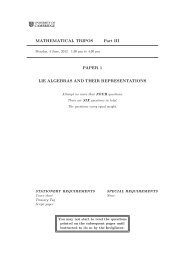MATHEMATICAL TRIPOS Part II PAPER 4 Before you begin read ...
MATHEMATICAL TRIPOS Part II PAPER 4 Before you begin read ...
MATHEMATICAL TRIPOS Part II PAPER 4 Before you begin read ...
- No tags were found...
You also want an ePaper? Increase the reach of your titles
YUMPU automatically turns print PDFs into web optimized ePapers that Google loves.
7<br />
13K Statistical Modelling<br />
Let (X 1 , Y 1 ), . . . , (X n , Y n ) be jointly independent and identically distributed with<br />
X i ∼ N(0, 1) and conditional on X i = x, Y i ∼ N(xθ, 1), i = 1, 2, . . . , n.<br />
(a) Write down the likelihood of the data (X 1 , Y 1 ), . . . , (X n , Y n ), and find the maximum<br />
likelihood estimate ˆθ of θ. [You may use properties of conditional probability/expectation<br />
without providing a proof.]<br />
(b) Find the Fisher information I(θ) for a single observation, (X 1 , Y 1 ).<br />
(c) Determine the limiting distribution of √ n(ˆθ − θ). [You may use the result on<br />
the asymptotic distribution of maximum likelihood estimators, without providing a<br />
proof.]<br />
(d) Give an asymptotic confidence interval for θ with coverage (1−α) using <strong>you</strong>r answers<br />
to (b) and (c).<br />
(e) Define the observed Fisher information. Compare the confidence interval in part (d)<br />
with an asymptotic confidence interval with coverage (1 − α) based on the observed<br />
Fisher information.<br />
(f) Determine the exact distribution of (∑ n<br />
) 1/2<br />
i=1 X2 i (ˆθ − θ) and find the true coverage<br />
probability for the interval in part (e). [Hint. Condition on X 1 , X 2 , . . . , X n and<br />
use the following property of conditional expectation: for U, V random vectors, any<br />
suitable function g, and x ∈ R,<br />
P {g(U, V ) x} = E[P {g(U, V ) x|V }].]<br />
14D Dynamical Systems<br />
What is meant by the statement that a continuous map of an interval I into itself<br />
has a horseshoe State without proof the properties of such a map.<br />
Define the property of chaos of such a map according to Glendinning.<br />
A continuous map f : I → I has a periodic orbit of period 5, in which the elements<br />
x j , j = 1, . . . , 5 satisfy x j < x j+1 , j = 1, . . . , 4 and the points are visited in the order<br />
x 1 → x 3 → x 4 → x 2 → x 5 → x 1 . Show that the map is chaotic. [The Intermediate Value<br />
theorem can be used without proof.]<br />
<strong>Part</strong> <strong>II</strong>, Paper 4<br />
[TURN OVER


